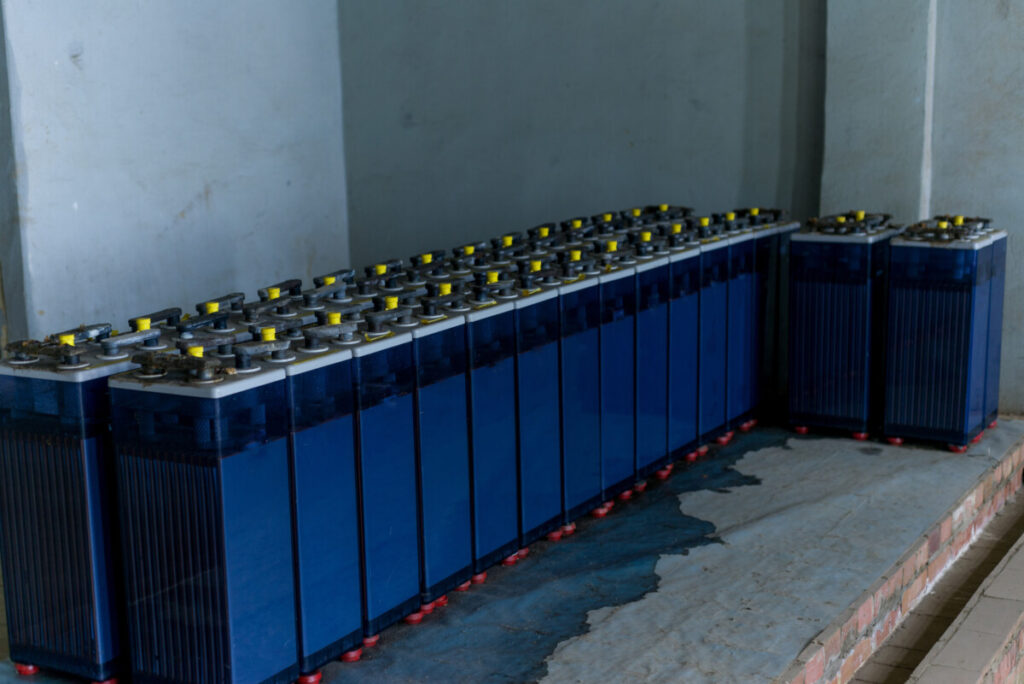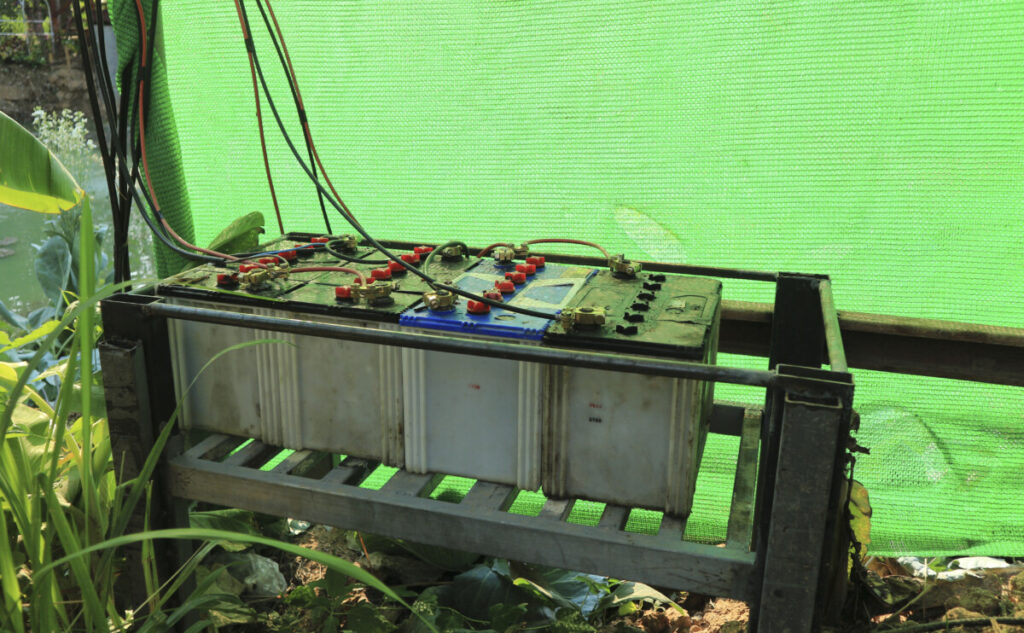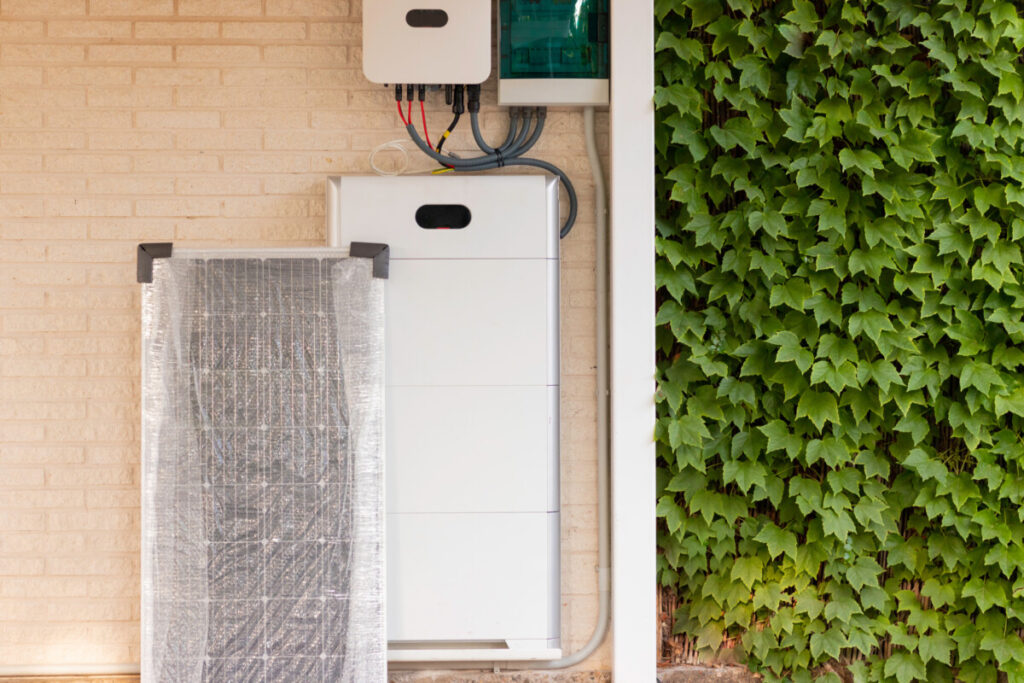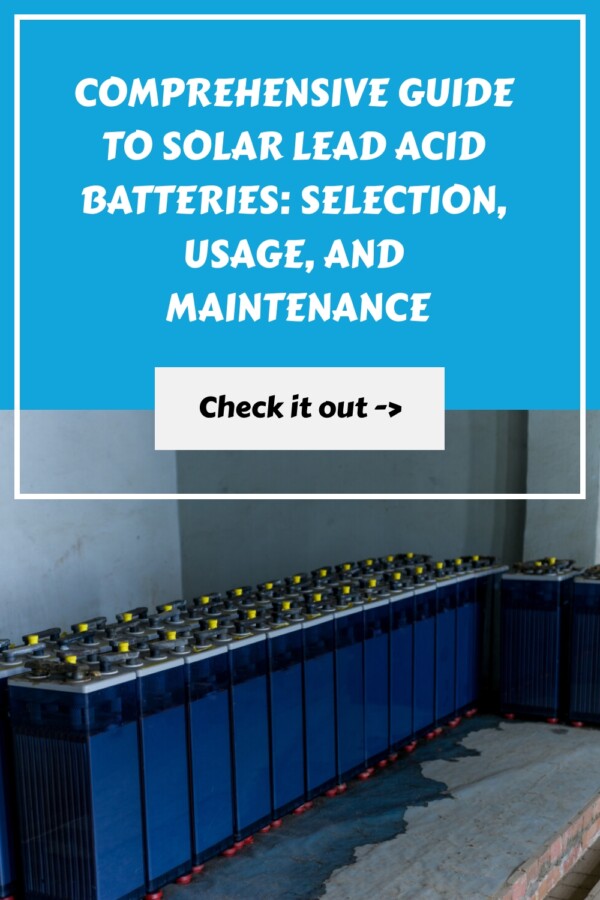Explore the world of solar lead acid batteries, a cornerstone of renewable energy storage. This guide delves into these batteries’ selection, usage, and maintenance, detailing types like Flooded, Sealed, Gel, and AGM.
Understand their role in solar systems, weigh their advantages against limitations, and consider crucial factors for optimal performance. Whether you’re an eco-conscious homeowner or a solar energy enthusiast, this comprehensive guide equips you with the knowledge to harness solar power effectively.
What are lead acid batteries?

Lead acid batteries are the most commonly used type of rechargeable batteries. They consist of lead plates submerged in an electrolyte solution of sulfuric acid. Lead acid batteries are known for their relatively low cost, high energy density, and ability to deliver high currents.
Example product specifications of a lead acid battery:
| Specification | Description |
|---|---|
| Battery Type | Solar lead acid battery |
| Voltage | 12V |
| Capacity | 100Ah |
| Weight | 25 kg (varies depending on capacity) |
| Dimensions | 330 x 175 x 220 mm (may vary) |
| Cycle Life | 600 cycles @ 50% DOD |
| Operating Temperature | -20°C to 50°C |
| Terminal Type | T11 (varies with model) |
| Warranty | 1 year (varies with brand) |
How are lead-acid batteries used in solar energy systems?

Lead acid batteries play a vital role in solar energy systems, as they store the electricity generated by solar panels for later use. When sunlight hits the solar panels, it generates DC (direct current) electricity.
But, this electricity must be converted into AC (alternating current) to power most household appliances. During periods of low sunlight or at night, the stored energy in the lead acid batteries is used to power the electrical loads.
Advantages
- Cost-effective: Lead-acid batteries are more affordable than rechargeable batteries, making them popular for solar energy storage.
- Proven technology: Lead acid batteries have been around for many years and have a proven reliability and performance track record.
- High surge capability: Lead acid batteries can deliver high currents, making them suitable for applications that require a sudden surge of power.
Disadvantages
- Profound discharge limitation: Lead acid batteries should not be discharged below a specific voltage to prevent damage and reduce lifespan.
- Maintenance: Lead acid batteries require regular maintenance, including checking and replenishing the electrolyte levels, cleaning the terminals, and ensuring proper ventilation.
- Weight and size: Lead acid batteries are relatively heavy and bulky compared to other types of batteries, which can be a disadvantage in specific applications where space and weight are a concern.
Overall, lead-acid batteries are popular for solar energy systems due to their cost-effectiveness and proven reliability.
They come with some limitations, such as the need for regular maintenance and the potential for reduced lifespan if not properly maintained. Considering these factors is crucial when determining the best battery option for a solar energy system.
Types of Solar Lead Acid Batteries
Lead-acid batteries are popular for solar power storage due to their reliability, affordability, and long lifespan. There are a few types of lead-acid batteries specifically designed for solar applications. Here are the most common types:
Flooded Lead Acid Batteries

- Flooded lead acid batteries, also known as wet cell batteries, are the traditional and most commonly used type of lead acid battery for solar power systems.
- These batteries contain a liquid electrolyte solution of sulfuric acid and water. Hence the name “flooded.”
- They require regular maintenance, including checking and refilling the electrolyte levels.
- Flooded lead acid batteries are known for their durability and ability to handle deep discharges, making them suitable for off-grid solar systems.
Sealed Lead Acid Batteries

- Sealed lead acid batteries, or SLA batteries, are maintenance-free batteries that do not require the user to check or refill electrolyte levels.
- They are sealed to prevent leakage and corrosion and are often used in small-scale solar power systems.
- SLA batteries use a valve-regulated design that allows the release of excess gas buildup, making them safer to use and transport.
Gel Lead Acid Batteries

- Gel lead acid batteries utilize a thickening agent to immobilize the sulfuric acid electrolyte, creating a gel-like substance.
- They are highly resistant to vibration, shocks, and high temperatures, making them suitable for harsh environments.
- Gel batteries have a low self-discharge rate and are often used in solar power systems that require deep cycling performance.
Absorbent Glass Mat (AGM) Lead Acid Batteries

- AGM lead acid batteries are constructed with a fiberglass mat soaked in sulfuric acid electrolytes.
- The mat absorbs the acid, keeping it close to the plates and enhancing the battery’s efficiency and performance.
- AGM batteries are maintenance-free, spill-proof, and have a low self-discharge rate.
- They are known for their excellent deep cycling capabilities and are commonly used in various solar power applications.
Understanding the different types of solar lead acid batteries is crucial in choosing the correct one for your solar power system. Factors such as intended usage, maintenance requirements, and budget should be considered when selecting.
For more information on solar lead acid batteries and their applications, you can visit Solar Power World.
See Related: Best Zero Waste Products: Eco-Friendly Choices
Features of Solar Lead Acid Battery
Suppose you’re considering using solar energy as a power source. In that case, one of the critical components you will need is a reliable battery system to store and supply electricity when the sun is not shining. One popular option is a solar lead acid battery, which offers a few noteworthy features:
- Affordability: Solar lead acid batteries are relatively affordable compared to other battery types, making them a cost-effective choice for solar power systems.
- Long life span: These batteries have a long lifespan, typically 5 to 15 years, depending on usage and maintenance. They can provide reliable energy storage for an extended period with proper care.
- Robustness and durability: Solar lead acid batteries are designed to withstand harsh environmental conditions like extreme temperatures and humidity. They are also resistant to shock and vibration, making them suitable for outdoor applications.
- Deep cycle capability: Solar lead acid batteries are deep cycle batteries, which can be discharged and recharged multiple times without compromising performance. This feature makes them ideal for powering off-grid solar systems where regular cycling is required.
- Ease of maintenance: These batteries are relatively easy to maintain, requiring occasional checks on electrolyte levels and the periodic addition of distilled water. This simplicity of care is an advantage for users who prefer hassle-free battery systems.
- Availability and compatibility: Solar lead acid batteries are widely available on the market, making them easily accessible for installation and replacement. They are compatible with a range of solar systems and integrate seamlessly into most setups.
- Safety: Lead acid batteries have a proven safety record, and their technology is well-established. With proper handling and installation, they pose minimal risk of fire or other hazards.
In summary, solar lead acid batteries are an affordable and durable energy storage solution that can extend the usability of solar power systems. Their long life span, deep cycle capability, ease of maintenance, and availability make them an attractive option for residential and commercial applications.
Factors to Consider When Choosing a Solar Lead Acid Battery
When choosing a solar lead acid battery for your solar power system, there are a few crucial factors to consider. These factors will help you determine the right battery for your needs and ensure optimal performance and longevity. Here are three key factors to keep in mind:
Capacity and Voltage Requirements
- Capacity: One of the first considerations when choosing a solar lead acid battery is the required power. Capacity refers to the amount of energy a battery can store and is typically measured in ampere-hours (Ah). Choosing a battery that can meet your energy needs is crucial, considering factors such as daily energy consumption and the number of hours of backup power required. A higher-capacity battery will provide more energy storage but may also be more extensive and expensive.
- Voltage: Another crucial consideration is the voltage requirements of your solar power system. Lead acid batteries are available in various voltages, including 6V, 12V, and 24V. Selecting a battery with a voltage that matches or is compatible with your solar panels, inverter, and other system components is crucial. Mismatched voltages can result in inefficient energy conversion and negatively impact your system’s overall performance.
Cycle Life and DOD (Depth of Discharge)
- Cycle Life: Cycle life refers to the number of charge-discharge cycles a battery can undergo before its capacity significantly degrades. Higher cycle life is desirable as the battery will last longer and provide consistent performance over time. When comparing different batteries, it’s crucial to consider their cycle life and choose a battery with more cycles.
- DOD (Depth of Discharge): DOD refers to the extent to which a battery’s capacity is used during each cycle. It’s recommended to avoid discharging the battery below a certain DOD threshold, as deep discharges can shorten the battery’s overall lifespan. Choosing a higher DOD percentage battery will allow for more usable capacity and provide better efficiency.
Maintenance and Safety Considerations
- Maintenance: Different types of lead acid batteries require varying levels of care. Some batteries may require regular checks and maintenance, such as topping electrolyte levels or equalizing charges, while others may be maintenance-free. When selecting a storm, it’s crucial to consider your capacity and willingness to perform required maintenance tasks.
- Safety: Safety is a critical consideration when selecting any battery. Ensure your battery has appropriate safety features, such as built-in protection against overcharging, short circuits, or thermal runaway. Following the manufacturer’s instructions for safe handling, installation, and battery use is crucial.
See Related: Best Pool Heater Solar Panels
Popular Brands and Models of Solar Lead Acid Batteries
Consumers trust a few popular brands and models when it comes to solar lead acid batteries. These brands offer reliable and durable batteries specifically designed for solar applications. Here are some top brands and models to consider:
Trojan Battery

Trojan Battery: Trojan is a well-known battery industry brand offering a wide range of solar batteries. Their batteries are known for their long cycle life, excellent performance, and reliability. The Trojan T-105 is a popular model widely used in solar energy systems. It has a capacity of 225Ah and is designed to provide reliable power for off-grid solar applications.
Vmaxtanks

Vmaxtanks: Vmaxtanks is another reputable brand specializing in deep-cycle solar applications batteries. Their batteries are known for their high capacity, long lifespan, and exceptional performance. The Vmaxtanks SLR125 is a popular model that offers 125Ah and is designed to provide reliable power for solar systems. It’s a sealed lead acid battery, requiring minimal maintenance, and is safe to use.
Renogy

Renogy: Renogy is a well-known brand in the solar industry, and they offer a range of products for solar power systems, including solar panels, charge controllers, and batteries. Renogy’s batteries are designed for high performance and long life in solar applications. The Renogy 12V 100Ah Deep Cycle AGM Battery is a popular model that offers a capacity of 100Ah and is designed to provide reliable and maintenance-free power for solar systems.
Universal Power Group (UPG)

Universal Power Group (UPG): UPG is a leading supplier of batteries and power accessories. They offer a range of batteries for a range of applications, including solar energy systems. Their batteries are known for their durability, reliability, and high performance. The UPG UB121000 is a popular model that offers a capacity of 100Ah and is designed to provide dependable power for solar systems.
Installation and Maintenance Tips for Solar Lead Acid Batteries

Following proper installation and maintenance guidelines is crucial to ensure the optimal performance and longevity of your solar lead acid batteries. Here are some tips to help you make the most out of your battery system:
Proper battery sizing and connection
- Determine the correct battery size: It is crucial to accurately calculate your energy requirements before purchasing batteries for your solar system. Consider factors such as daily energy consumption, peak loads, and days of autonomy to determine the correct battery capacity.
- Connect batteries in series or parallel: Depending on your system voltage requirements, you may need to connect multiple batteries in series or parallel. This connection ensures the batteries work harmoniously to provide the necessary power output.
- Use appropriate cables and connectors: Ensure you use cables and connectors that can handle the amperage of your battery system. Oversized or undersized cables can lead to inefficient power transfer and potential safety hazards.
Regular maintenance and monitoring
- Monitor battery voltage: You can use a multimeter to ensure it remains within the optimal charging and discharging range. High or low voltages can indicate a battery or charging system problem.
- Keep the batteries clean: Regularly clean the battery terminals and connections to prevent dirt, corrosion, and sulfation buildup. Dirty contacts can hinder the flow of electricity and reduce battery performance.
- Equalize the batteries: Periodically equalize the batteries to balance the charge of individual cells. This helps prevent stratification, where the electrolyte concentration becomes uneven over time.
Safety precautions
- Ventilation: When installing lead acid batteries, ensure the area is well-ventilated to prevent the buildup of explosive hydrogen gas. Avoid installing batteries in enclosed spaces without proper ventilation.
- Wear protective gear: Use gloves, safety glasses, and protective clothing when handling lead-acid batteries. Battery acid and sulfation can cause skin irritation and other health hazards.
- Follow manufacturer instructions: Always follow the manufacturer’s instructions for installation, maintenance, and charging procedures. Each battery type and brand may have specific requirements and guidelines.
See Related: Best Solar Power Banks to Buy Today
Comparison With Other Types of Solar Batteries (e.g., Lithium-ion)

When considering solar batteries for your energy storage needs, it’s crucial to compare different types of batteries to determine the best fit for your specific requirements.
Lead acid batteries are one of the most commonly used battery chemistries in solar applications, but how do they compare to other battery types, such as lithium-ion? Let’s look at the pros and cons of lead acid batteries compared to different battery chemistries.
Pros and cons of lead acid batteries compared to other battery chemistries
Lead Acid Batteries
Pros
- Lower cost: Lead-acid batteries are generally more affordable than other battery chemistries, making them a popular choice for budget-conscious consumers.
- Widespread availability: Lead acid batteries have been around for a long time and are widely available in a range of sizes and capacities.
- Tolerance to overcharging: Lead acid batteries are more forgiving when overcharging, which can benefit solar applications where system malfunctions may occur.
Cons
- Low energy density: Lead acid batteries have a lower energy density than lithium-ion batteries, meaning they store less energy per unit weight or volume.
- Limited cycle life: Lead-acid batteries have a shorter lifespan and fewer charge-discharge cycles than lithium-ion batteries.
- Higher maintenance requirements: Lead acid batteries require regular maintenance, including topping up with distilled water and ensuring proper ventilation to prevent gas accumulation.
Lithium-ion Batteries
Pros
- Higher energy density: Lithium-ion batteries have a higher energy density, allowing them to store more energy per unit weight or volume than lead-acid batteries.
- Longer lifespan: Lithium-ion batteries generally have a longer lifespan and can withstand more charge-discharge cycles.
- Lower maintenance requirements: Lithium-ion batteries are virtually maintenance-free, making them more convenient for users.
Cons
- Higher cost: Lithium-ion batteries are typically more expensive than lead-acid batteries, which can be a significant consideration for those on a tight budget.
- Safety concerns: While rare, lithium-ion batteries can be more prone to thermal runaway and fire hazards if not properly managed or protected.
Considerations for specific applications or budget constraints
When choosing between lead-acid and lithium-ion batteries for your solar application, a few factors come into play, including:
- Energy requirements and available space: If you need a higher-capacity battery in a limited space, lithium-ion batteries may be a better fit due to their higher energy density.
- Budget constraints: Lead acid batteries are generally more affordable upfront, making them an attractive option for consumers with budget limitations.
- Cycle life requirements: If longevity and the number of charge-discharge cycles are critical for your application, lithium-ion batteries may be the better choice due to their longer lifespan.
Choosing high-quality solar lead acid batteries from reputable manufacturers is crucial to ensure reliable performance and durability. By understanding the different types of storms and their specific features, you can make an informed decision when selecting a solar lead acid battery for your solar energy storage needs.
For more information about solar lead acid batteries, you can check out this helpful guide on the pros and cons of commercial solar battery systems.
Investing in a solar lead acid battery can provide numerous benefits, including reduced reliance on the grid, lower energy costs, and a reduced environmental impact. With the advancements in battery technology, solar lead acid batteries are becoming an increasingly attractive solution for those looking to integrate renewable energy into their daily lives.
Thank you for reading this comprehensive guide on solar lead acid batteries. We hope you found it informative and helpful in your journey toward sustainable and efficient energy storage.
Related Resources
- Best Solar Charge Controllers
- Best Solar Power Banks to Buy Today
- Mastering Solar Panel Direction: A Guide to Optimal Energy Harvesting


